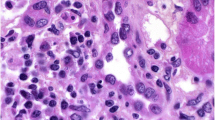Summary
Nivolumab, a programmed death 1 blockade drug, is used in various types of cancers and can cause a unique immune-related adverse event (irAE). Relapsing polychondritis (RP) is a rare autoimmune disease that mainly involves inflammation of the auricle, nose and airway cartilage. A 72-year-old man with mandibular cancer received nivolumab after surgery for the primary lesion and radiation therapy for lung metastases. He then developed radiation pneumonitis, and prednisolone (PSL) was started. During the tapering of PSL, he developed exertional dyspnea and cough. The condition of mandibular cancer and radiation pneumonitis had not deteriorated. Fluorodeoxyglucose (FDG)-PET/CT showed a thickening of and abnormal FDG uptake in the tracheobronchial and nasal septum cartilage. These characteristic findings were not observed before nivolumab was initiated; thus, we clinically diagnosed the patient as having RP induced by nivolumab. Since the symptoms were mild, the patient’s condition was carefully managed with inhaled corticosteroids, and the RP has not progressed thus far. Physicians should be aware that RP can occur as an irAE because RP may progress to serious respiratory symptoms.

Similar content being viewed by others
Data availability
Not applicable.
Code availability
Not applicable.
References
Trentham DE, Le CH (1998) Relapsing polychondritis. Ann Intern Med 129(2):114–122. https://doi.org/10.7326/0003-4819-129-2-199807150-00011
McAdam LP, O’Hanlan MA, Bluestone R, Pearson CM (1976) Relapsing polychondritis: prospective study of 23 patients and a review of the literature. Medicine (Baltimore) 55(3):193–215
Damiani JM, Levine HL (1979) Relapsing polychondritis–report of ten cases. Laryngoscope 89(6):929–946
Michet CJ Jr, McKenna CH, Luthra HS, O'Fallon WM (1986) Relapsing polychondritis. Survival and predictive role of early disease manifestations. Ann Intern Med 104(1):74–78. https://doi.org/10.7326/0003-4819-104-1-74
Sharma A, Kumar R, Mb A, Naidu G, Sharma V, Sood A, Dhir V, Verma R, Singh H, Bhattacharya A, Jain S, Mittal BR (2020) Fluorodeoxyglucose positron emission tomography/computed tomography in the diagnosis, assessment of disease activity and therapeutic response in relapsing polychondritis. Rheumatology (Oxford) 59(1):99–106. https://doi.org/10.1093/rheumatology/kez243
Lei W, Zeng H, Zeng DX, Zhang B, Zhu YH, Jiang JH, Huang JA (2016) (18)F-FDG PET-CT: a powerful tool for the diagnosis and treatment of relapsing polychondritis. Br J Radiol 89(1057):20150695. https://doi.org/10.1259/bjr.20150695
Tsuburai T, Suzuki M, Tsurikisawa N, Ono E, Oshikata C, Taniguchi M, Akiyama K (2009) Use of inhaled fluticasone propionate to control respiratory manifestations of relapsing polychondritis. Respirology 14(2):299–301. https://doi.org/10.1111/j.1440-1843.2008.01455.x
Kuba K, Nakahira M, Inoue H, Kogashiwa Y, Ebihara Y, Sugasawa M (2020) Nivolumab-related tracheobronchial chondritis: extremely rare manifestation of an immune-related adverse effect. Head Neck 42(11):E43–E48. https://doi.org/10.1002/hed.26456
Funding
This research did not receive any specific grant from funding agencies in the public, commercial, or not-for-profit sectors.
Author information
Authors and Affiliations
Contributions
All authors contributed to the study conception and design. Data collection and analysis were performed by Tatsuya Ogimoto, Hironori Yoshida, Masanobu Mizuta and Toyohiro Hirai. The first draft of the manuscript was written by Tatsuya Ogimoto and all authors commented on previous versions of the manuscript. All authors read and approved the final manuscript.
Corresponding author
Ethics declarations
Ethics approval
All procedures performed in studies involving human participants were in accordance with the ethical standards of the institutional and/or national research committee and with the 1964 Helsinki declaration and its later amendments or comparable ethical standards.
Consent to participate
Informed consent to participate was obtained from the patient.
Consent for publication
Informed consent was obtained from the patient.
Conflicts of interest
The authors declare that they have no conflict of interest.
Additional information
Publisher's Note
Springer Nature remains neutral with regard to jurisdictional claims in published maps and institutional affiliations.
Rights and permissions
About this article
Cite this article
Ogimoto, T., Yoshida, H., Mizuta, M. et al. Relapsing polychondritis after treatment with PD-1 blockade. Invest New Drugs 40, 389–391 (2022). https://doi.org/10.1007/s10637-021-01186-3
Received:
Accepted:
Published:
Issue Date:
DOI: https://doi.org/10.1007/s10637-021-01186-3




